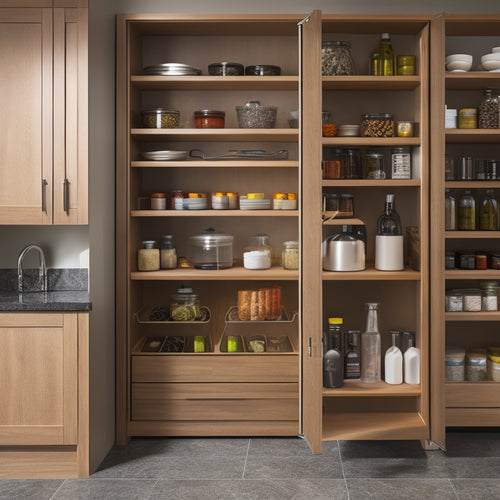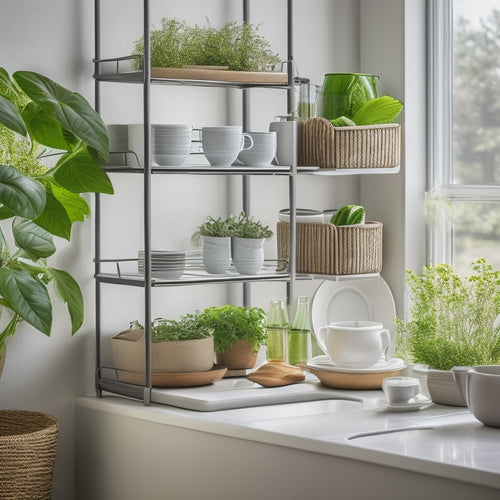
FDA-Compliant Tanks: Key Points for Buyers
Share
When purchasing FDA-compliant tanks for food and beverage processing, buyers must prioritize compliance to guarantee product safety and quality. Understanding FDA compliance is essential, as the agency does not directly approve tanks or machinery, and manufacturers must meet standards. Tank material selection is also important, as it impacts stored content quality and purity. Non-reactive and non-contaminating materials like XLPE and stainless steel are popular options. A well-designed tank with effective drainage and high-quality manufacturing is vital for preventing contamination and ensuring reliable storage solutions. By considering these key factors, buyers can make informed decisions to guarantee compliance and ideal storage solutions.
Key Takeaways
• FDA compliance relies on manufacturers meeting standards for food-grade storage, including materials, construction, and performance.
• Tank material selection is crucial, with XLPE and stainless steel being popular options that must be non-reactive, non-contaminating, and easy to clean.
• Well-designed tanks with effective drainage solutions are essential for preventing contamination and ensuring reliable storage.
• Reputable manufacturers provide testing data to ensure compliance, and buyers should compare costs and benefits of different materials.
• Proper tank maintenance is vital for preserving food product integrity and extending tank longevity, which can range from 15 to 20+ years.
Understanding FDA Compliance
Since the FDA does not provide direct approvals for tanks or machinery, manufacturers must verify that their equipment meets the agency's strict standards for food-grade storage and processing. This means that tank specifications must align with FDA regulations for materials, construction, and performance.
Manufacturers must guarantee their tanks meet these standards, as the FDA only approves additives, not equipment. It is essential to choose a reputable manufacturer that can provide documentation and testing data to support their claims of FDA compliance.
Tank Material Considerations
What factors should be pondered when selecting the ideal material for FDA-compliant tanks, given the vital role it plays in safeguarding the safety and integrity of stored food products?
The choice of tank material is pivotal, as it directly impacts the quality and purity of the stored contents. Industry standards dictate that tank materials must be non-reactive, non-contaminating, and easy to clean.
XLPE (cross-linked polyethylene) and stainless steel are popular options, each with their own advantages and limitations. XLPE tanks offer a cost-effective, low-maintenance solution, while stainless steel tanks provide a high-end option suitable for non-harsh chemicals.
When selecting a tank material, it is crucial to ponder factors such as durability, corrosion resistance, and compliance with FDA regulations to safeguard the safe storage of food products.
Ensuring Reliable Storage Solutions
Three important factors to guarantee dependable storage solutions are tank design, manufacturing quality, and compliance with FDA regulations, all of which play a vital role in preventing contamination and preserving the integrity of stored food products.
A well-designed tank with effective drainage solutions is essential for preventing contamination and ensuring proper tank maintenance.
Additionally, a tank's longevity is directly linked to its manufacturing quality, with high-quality tanks lasting 15 to 20+ years.
When comparing tank options, it's crucial to take into account the cost comparison between materials, such as XLPE and stainless steel, to guarantee the most cost-effective solution for your food storage needs.
Frequently Asked Questions
What Certifications Should I Look for in an Fda-Compliant Tank?
When evaluating FDA-compliant tanks, look for certifications that guarantee tank compatibility with your specific application, such as NSF International or ASME, and verify that the manufacturer meets certification requirements for material, design, and fabrication.
Can I Use a Tank for Multiple Types of Food Storage?
'While it may seem convenient to use a single tank for multiple types of food storage, cross contamination risks and storage compatibility issues must be carefully considered to maintain the integrity of each product and prevent potential health hazards.'
How Do I Ensure My Tank Remains Compliant Over Time?
To guarantee long-term compliance, implement a proactive maintenance schedule, conduct regular compliance monitoring, and perform routine inspections to identify and address potential issues, thereby maintaining a safe and compliant storage environment.
Are There Any Specific Cleaning Requirements for Fda-Compliant Tanks?
To maintain FDA compliance, tanks require rigorous cleaning procedures and maintenance schedules. Implementing standardized cleaning protocols, sanitization routines, and regular inspections helps prevent contamination, reduces risk, and guarantees a safe storage environment.
Can I Customize an Fda-Compliant Tank to Fit My Specific Needs?
'Diversity is the spice of life,' and when it comes to FDA-compliant tanks, customization options abound. Look for manufacturers that offer special features, such as unique sizes, shapes, and accessories, to tailor a tank to your specific needs and guarantee peak performance and safety.
Related Posts
-

Space-Saving Lazy Susan Cabinet Solutions
Space-saving Lazy Susan cabinet solutions can change those awkward corner spaces into organized storage wonders. You'...
-

Over-The-Door Kitchen Rack Installation Tips
To install an over-the-door kitchen rack effectively, start by measuring your door's clearance to guarantee a proper ...
-

Tiered Dish Rack Organizers for Compact Spaces
Tiered dish rack organizers are perfect for compact spaces, maximizing vertical storage while saving precious counter...


